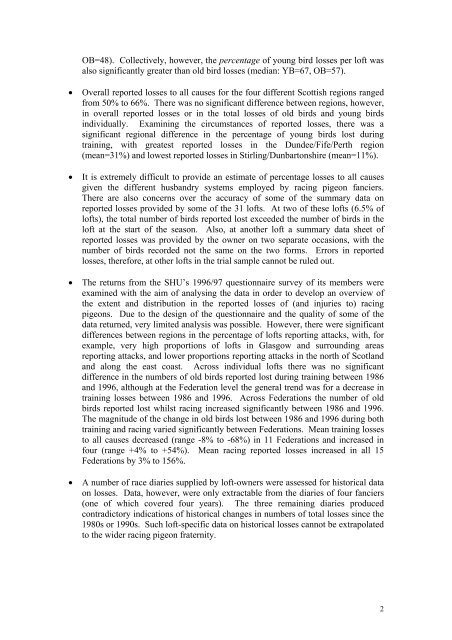RACING PIGEONS â IMPACT OF RAPTOR PREDATION
RACING PIGEONS â IMPACT OF RAPTOR PREDATION
RACING PIGEONS â IMPACT OF RAPTOR PREDATION
You also want an ePaper? Increase the reach of your titles
YUMPU automatically turns print PDFs into web optimized ePapers that Google loves.
OB=48). Collectively, however, the percentage of young bird losses per loft was<br />
also significantly greater than old bird losses (median: YB=67, OB=57).<br />
• Overall reported losses to all causes for the four different Scottish regions ranged<br />
from 50% to 66%. There was no significant difference between regions, however,<br />
in overall reported losses or in the total losses of old birds and young birds<br />
individually. Examining the circumstances of reported losses, there was a<br />
significant regional difference in the percentage of young birds lost during<br />
training, with greatest reported losses in the Dundee/Fife/Perth region<br />
(mean=31%) and lowest reported losses in Stirling/Dunbartonshire (mean=11%).<br />
• It is extremely difficult to provide an estimate of percentage losses to all causes<br />
given the different husbandry systems employed by racing pigeon fanciers.<br />
There are also concerns over the accuracy of some of the summary data on<br />
reported losses provided by some of the 31 lofts. At two of these lofts (6.5% of<br />
lofts), the total number of birds reported lost exceeded the number of birds in the<br />
loft at the start of the season. Also, at another loft a summary data sheet of<br />
reported losses was provided by the owner on two separate occasions, with the<br />
number of birds recorded not the same on the two forms. Errors in reported<br />
losses, therefore, at other lofts in the trial sample cannot be ruled out.<br />
• The returns from the SHU’s 1996/97 questionnaire survey of its members were<br />
examined with the aim of analysing the data in order to develop an overview of<br />
the extent and distribution in the reported losses of (and injuries to) racing<br />
pigeons. Due to the design of the questionnaire and the quality of some of the<br />
data returned, very limited analysis was possible. However, there were significant<br />
differences between regions in the percentage of lofts reporting attacks, with, for<br />
example, very high proportions of lofts in Glasgow and surrounding areas<br />
reporting attacks, and lower proportions reporting attacks in the north of Scotland<br />
and along the east coast. Across individual lofts there was no significant<br />
difference in the numbers of old birds reported lost during training between 1986<br />
and 1996, although at the Federation level the general trend was for a decrease in<br />
training losses between 1986 and 1996. Across Federations the number of old<br />
birds reported lost whilst racing increased significantly between 1986 and 1996.<br />
The magnitude of the change in old birds lost between 1986 and 1996 during both<br />
training and racing varied significantly between Federations. Mean training losses<br />
to all causes decreased (range -8% to -68%) in 11 Federations and increased in<br />
four (range +4% to +54%). Mean racing reported losses increased in all 15<br />
Federations by 3% to 156%.<br />
• A number of race diaries supplied by loft-owners were assessed for historical data<br />
on losses. Data, however, were only extractable from the diaries of four fanciers<br />
(one of which covered four years). The three remaining diaries produced<br />
contradictory indications of historical changes in numbers of total losses since the<br />
1980s or 1990s. Such loft-specific data on historical losses cannot be extrapolated<br />
to the wider racing pigeon fraternity.<br />
2
















